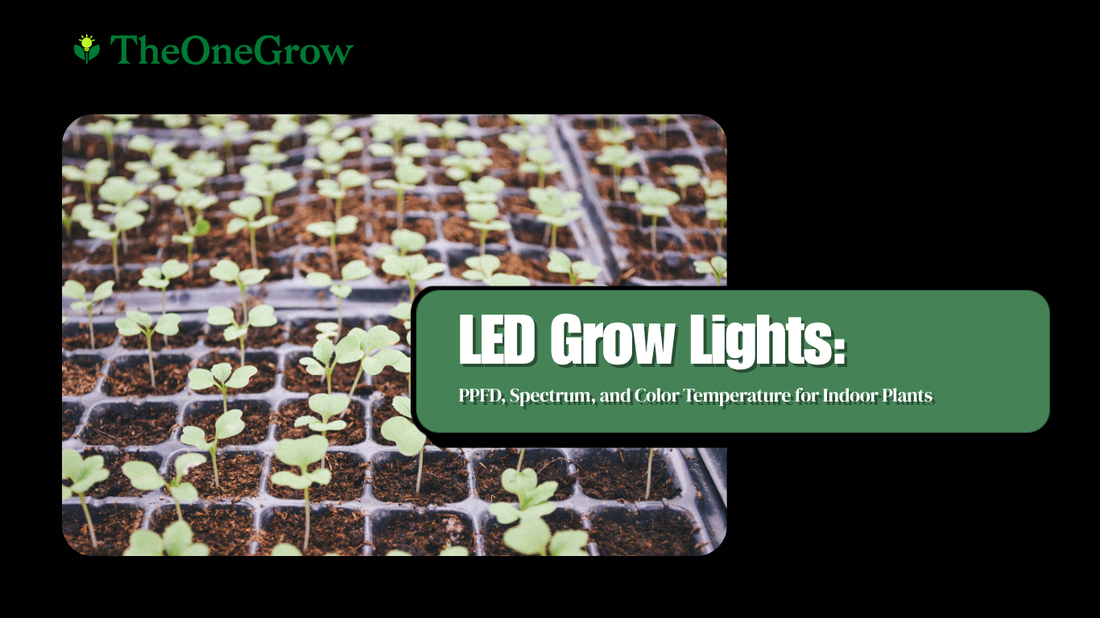
LED Grow Lights: PPFD, Spectrum, and Color Temperature for Indoor Plants
Whether you're growing herbs, vegetables, or flowers indoors, understanding light intensity (PPFD), spectrum, and color temperature is crucial for healthy plant growth. But, what kind of light do plants need? That's the crucial point that decide what kinds of grow light you should choose. Let us find out one by one!
✅ How much light (PPFD) different plants need?
✅ The role of color spectrum in plant growth
✅ Why full-spectrum LED grow lights outperform traditional lighting?
✅ How to choose the best LED grow lights for your indoor garden?
By the end, you'll know exactly what to look for in LED grow lights for indoor plants to maximize yields and plant health.
Part 1: Light Intensity (PPFD) – How Much Light Do Your Plants Need?
What is PPFD?
PPFD (Photosynthetic Photon Flux Density) measures how many light photons (in µmol/m²/s) reach your plants. Unlike lumens (which measure brightness for human eyes), PPFD tells you how effectively light fuels photosynthesis.
PPFD Requirements for Different Plants
| Plant Type | Seedlings | Vegetative | Flowering/Fruiting |
|---|---|---|---|
| Leafy Greens (Lettuce, Kale) | 100-200 µmol | 200-400 µmol | 300-600 µmol |
| Herbs (Basil, Mint) | 150-250 µmol | 300-500 µmol | 400-700 µmol |
| Fruiting Plants (Tomatoes, Peppers) | 200-300 µmol | 400-600 µmol | 600-900 µmol |
| Flowering Plants (Orchids, Roses) | 150-250 µmol | 300-500 µmol | 500-800 µmol |
| Weeds | 200-400 µmol | 600-1000µmol | 800-900 µmol |
Note: If you have co2 supplement during weeds growing, the ppfd should up to 1200 µmol/m2/s
Key Takeaways:
-
Low-light plants (e.g., lettuce) thrive under 200-400 µmol
-
Fruiting/flowering plants need 600+ µmol for best yields
-
Too much light can cause light burn, while too little leads to stretching
💡 Pro Tip: Use a PAR meter (or check your LED grow light’s specs) to ensure proper PPFD levels. For Indoor shade-loving plants( Tropical plants&Household potted plants),Just a little bit of additional lighting is needed, suitable for a simple, compact, and decorative furniture plant lamp. For leafy greens or herbs, several grow light tubes or grow light within 100W may do a satisfied job. For weeds and other fruiting/flowering plants, indoor planting requires a lot of light, so it's important to consider plant growth lights ranging from 200W to 1000W, so that your plants can have a good harvest!
Part 2: The Role of Light Spectrum in Plant Growth

Not all light is equal—plants use different wavelengths for various growth stages.
Understanding the Light Spectrum of LED Lights
| Color (nm) | Role in Plant Growth | Best For |
|---|---|---|
| Blue (400-500nm) | Promotes compact, bushy growth | Seedlings, vegetative growth |
| Red (600-700nm) | Encourages flowering & fruiting | Bloom phase |
| Far-Red (700-800nm) | Speeds up flowering, improves yield | Late flowering |
| Full Spectrum (White LEDs) | Mimics sunlight, balanced growth | All stages |
Why Full-Spectrum LED Grow Lights Are Best & common used
-
Blue + Red combo = Strong roots & big flowers
-
Far-red helps with photomorphogenesis (plant stretching control)
-
White LEDs (3000K-5000K) provide a natural balance
🔬 Science Fact: Chlorophyll absorbs most efficiently in blue & red, but green/yellow light still contributes to photosynthesis.
Part 3: Color Temperature – Does It Matter?
Color temperature (measured in Kelvin, K) affects plant behavior:
-
3000K (Warm White) – More red, ideal for flowering
-
4000K (Neutral White) – Balanced for full-cycle growth
-
5000K-6500K (Cool White) – More blue, great for seedling & vegetative growth
💡 Best Choice? A full-spectrum LED grow light gives the most flexibility.
Part 4: Choosing the Best LED Grow Lights for Indoor Plants
When shopping for LED grow lamps for indoor plants, look for:
✔ Adjustable spectrum or full spectrum (cover all stages)
✔ Suitable PPFD output (matching your plants’ needs)
✔ Energy efficiency (budget saving & eco-friendly)
✔ Dimmability (cover all stages)
Top Picks for Different Needs:
-
Hydroponics? Look for grow lights for hydroponics with wide coverage.
-
Compact setup? A small full-spectrum LED panel works best.
-
Commercial grow? High-PPFD bar-style LEDs maximize yield.
Conclusion: Optimize Your Grow with the Right LED Lights
Choosing the right LED grow lights for indoor plants means balancing:
PPFD (enough light for your plants)
Spectrum (blue for veg, red for flower)
Color temperature (3000K-6500K for different stages)
With a full-spectrum, adjustable LED grow light, you can grow healthier plants, faster—whether in soil, hydroponics, or a greenhouse.
Ready to upgrade your grow? [Browse our top-rated LED grow lights here!]
FAQ: LED Grow Lights Explained
1. Can I use regular LED lights instead of grow lights?
Regular LEDs lack the optimal spectrum & PPFD for plants. Dedicated grow lights perform much better.
2. How far should LED grow lights be from plants?
Generally speaking, it should based on PPFD & heat output according to different light& plants that you grow, but we can give a rough suggestion on different kinds of light.
For High PPFD Bar style lights:
-
Seedlings: 24-30 inches
-
Vegetative: 18-24 inches
-
Flowering: 12-18 inches
For light tubes grow leafy greens:
- 6-12 inches
3. Do plants need darkness?
Yes! Most plants require 6-8 hours of darkness for proper growth cycles.
4. Can LED grow lights burn plants?
Yes, if too close or too intense! Check PPFD levels and watch for leaf bleaching.
5. What’s the best LED spectrum for hydroponics?
A full-spectrum LED (4000K-5000K) works best for hydroponic systems, promoting fast growth in water-based setups.
Final Thoughts
Whether you're growing herbs, veggies, or flowers, the right LED grow light spectrum and intensity make all the difference.
Need help choosing? visit our homepage or contact us by mail:info@theonegrow.com 🌱
